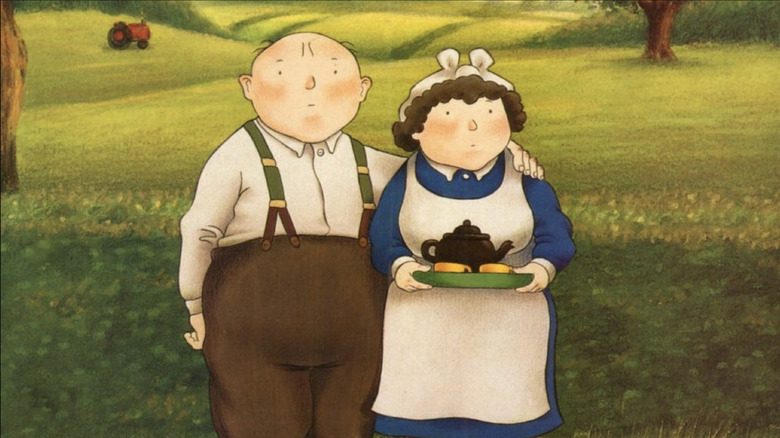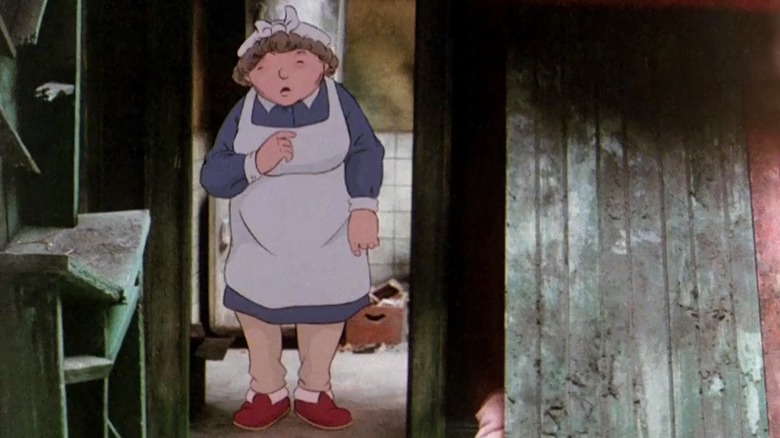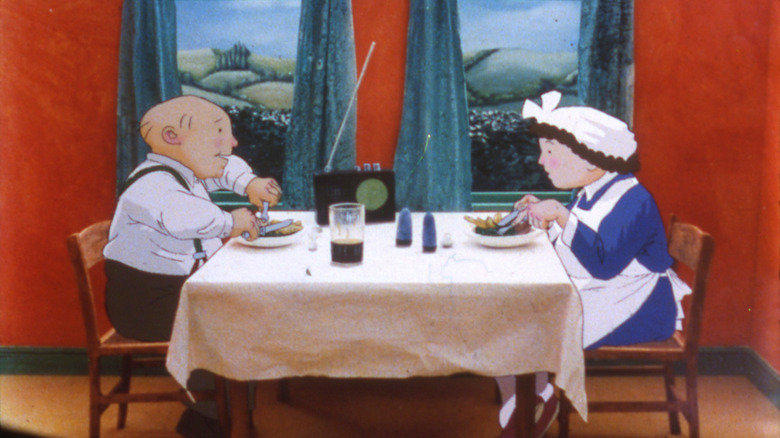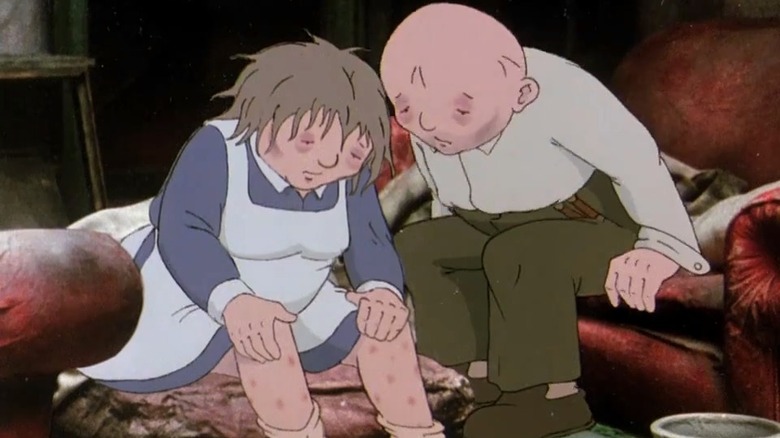When The Wind Blows Is A Devastating Blend Of Traditional Animation, Stop-Motion, And Roger Waters Music
(Welcome to Animation Celebration, a recurring feature where we explore the limitless possibilities of animation as a medium. In this edition: "When The Wind Blows.")
When thinking about animation geared toward adults, people often immediately think of hyper-violent anime like the recent Hulu series, "Chainsaw Man," or excessively vulgar comedies like "Sausage Party," which is getting a series reboot, by the way. With so many people falsely believing that animation is a genre and not a medium, animated features that aren't marketed with the caveat of "not being for kids," are often assumed to be meant for children simply because people foolishly forget that complex and challenging stories are frequently better suited without the limitations of live-action.
After successfully adapting Raymond Briggs' picture book "The Snowman," animator Jimmy Murakami decided to tackle Briggs' more adult graphic novel, "When The Wind Blows." The 1986 film tells the story of an elderly British couple enduring the effects of nuclear winter. Utilizing a similar artistic style from Briggs' beloved Christmas story, "When The Wind Blows" is presented in a hybrid of traditional and stop-motion animation to present a juxtaposed look at the sweet sensibilities of a pair of well-intentioned old folks in a tidy, isolated cottage in rural Sussex, and the devastating impacts of radiation poisoning.
"When The Wind Blows" is interesting in that it doesn't have anything in particular that couldn't be shown in live-action, but given the ridiculously bleak story, all of the sweetness and charm of the characters' optimism would be lost if we were watching a realistic portrayal of the effects of nuclear fallout on two adorable grandparents. The decision to keep the story in an animated medium allows the graphic novel's tone to remain, thereby preserving Briggs' artistic integrity.
A heartbreaking venture in inevitability
Academy Award-winners and prolific English actors John Mills and Peggy Ashcroft voice Jim and Hilda Bloggs, a semi-isolated elderly couple in the English countryside. Jim travels into the local town to keep informed through newspapers regarding the Soviet-Afghan War, but often doesn't fully understand the specifics of the guerilla conflict. He learns from a radio broadcast that a nuclear war with the Soviet Union is only days away, and begins preparing for impact by meticulously following the instructions featured on his government-issued "Protect and Survive" pamphlets. Hilda doesn't fully grasp the severity of the situation, and both lament learning that their adult son (who lives elsewhere) has seemingly fallen into fatalistic depression.
Jim builds a lean-to shelter out of doors and begins stocking supplies, becoming frustrated when "panic purchasing" by other townspeople has made it so there's no available bread. Jim continues following the instructions on the pamphlets to the letter, like believing painting the windows with white paint will somehow prevent the radiation from entering the house. Having already survived World War II, the Bloggs firmly believe that they will be just fine, despite the audience watching them knowing that all of their preparations are futile. After the nuclear missile strike makes contact, Jim and Hilda rush into their shelter, which is just doors behind a couch, as the shock waves rattle their house. After a few days of shelter, they emerge to find that everything is destroyed but do their best to live as they did before, unknowingly developing radiation poisoning in the process. The Bloggs will not survive this, and it's only a matter of time before they accept this inevitability as reality, as we bear witness to their tragic demise.
The pain of optimism
In the early stages of the fallout, it is downright painful to watch Jim and Hilda try to carry on as normal. They try to make tea, they make lists of the things they're going to do after it all blows over, and they enthusiastically await assistance from the government. The radioactive ash has eclipsed the sun, wildlife and vegetation have been destroyed, poisoned animals are scavenging the dead, and yet they are convinced that there is nothing to worry about. Part of why "When The Wind Blows" is so effective is the beginning of the film, and the animation style, would leads us to believe this is a heartwarming story about love defying the odds. In reality, it's a complete dismantling of the storybook optimism and a highly critical takedown of nostalgic nationalism.
The use of such familiar, comfortable animation is beguiling, which makes their death march toward destruction all the more harrowing. There's something so endearing at first to the stubbornness of Jim and Hilda, but it quickly turns to agonizing frustration as we watch members of a generation who bought into nationalistic nonsense in the wake of World War II actively participate in their own ruination. Despite the obvious parallels to the Cold War, "When the Wind Blows" is just as relatable today, especially in a post-Trump world where brainwashed fools continually vote against their best interests.
The craft emphasizes the sorrow
David Bowie was originally supposed to craft all of the music for the film, but left the project to finish his album "Never Let Me Down," allowing Roger Waters of Pink Floyd fame to fill the void. Bowie still provides the eponymous title track, which includes the devastating chorus of "So long child, it's awful dark, I never felt the sun. I daren't to think of when, when the wind blows." Genesis, Squeeze, Hugh Cornwell, and Paul Hardcastle also contribute to the soundtrack, pairing some of Britain's most political songwriters with a deeply political film.
By utilizing a hybrid of traditional and stop-motion animation, "When The Wind Blows" takes on an uncanny appearance, even for a film not in live-action. Jim and Hilda Bloggs are hand-drawn, as is most of the area outside of their home. However, the interior of their home and a majority of the objects they interact with are real, seldom moving but consistently animated with stop-motion if need be. This was meant to imitate the style of "Protect and Survive" public information films, which were created to advise on preparation suggestions in case of nuclear war despite being no more useful than a band-aid on a bullet hole. Bleak, dramatic, emotionally obliterating films are common in live-action, but a film as relentless (with a PG rating, no less) as "When The Wind Blows" is hard to find. The use of animation may have hurt the film's marketability and generationally shared legacy, but has allowed it to exist as one of the most poignant and painful animated films in history.
"When The Wind Blows" is currently available to stream on Tubi TV and The Roku Channel.



